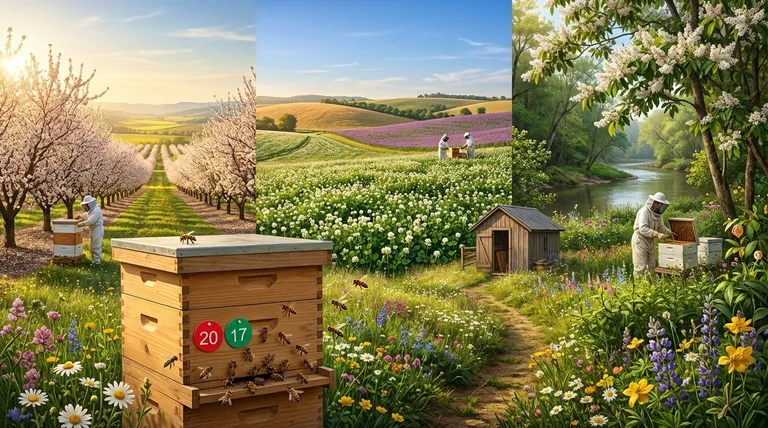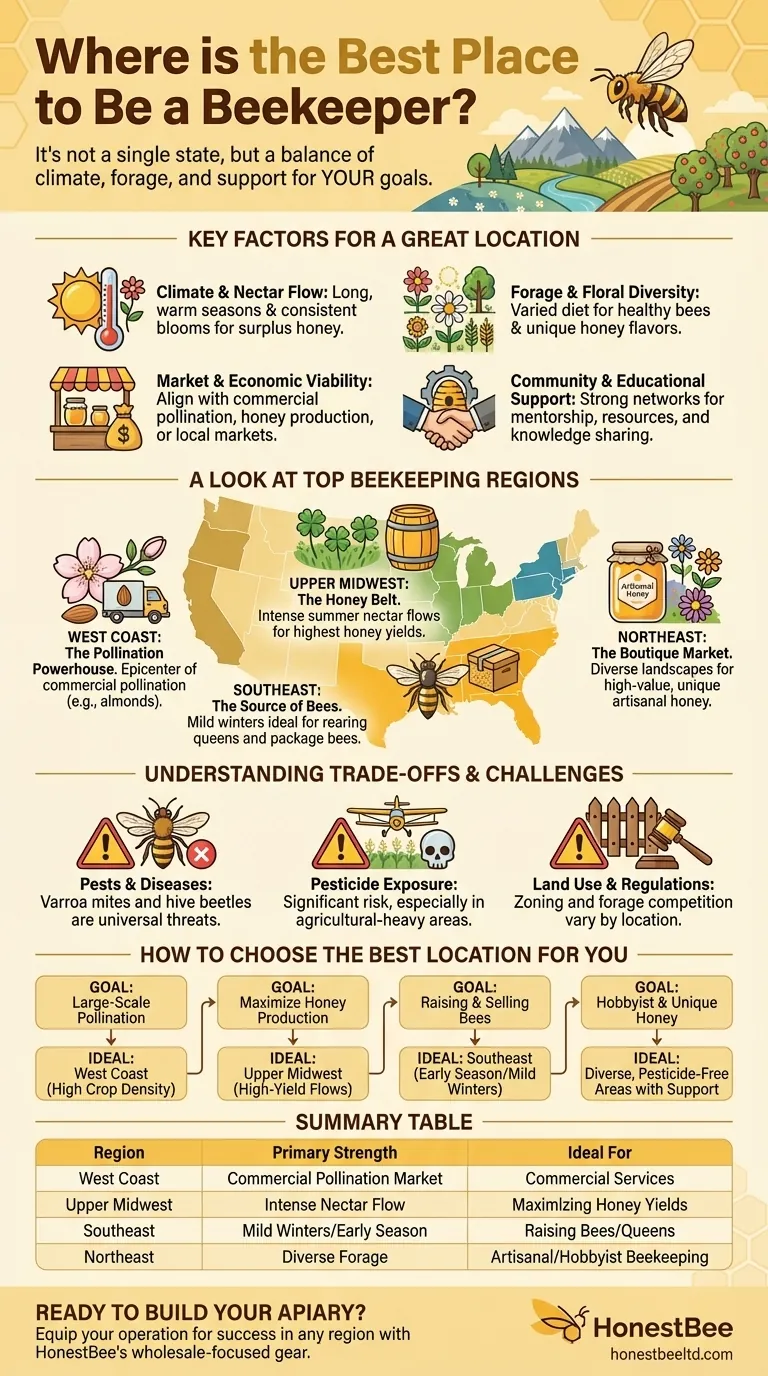While some regions are famous, the "best" place to be a beekeeper is not a single state but rather any location that provides the right balance of climate, forage, and community support for your specific goals. States like California are frequently cited due to their massive agricultural industry and a high number of beekeeping associations, which create extensive support networks and educational opportunities for beekeepers.
The ideal location for beekeeping is less about a specific state and more about matching your personal goals—whether for hobby, honey production, or commercial pollination—with the local environmental and economic conditions.

Key Factors that Define a Great Beekeeping Location
To determine what makes a location suitable, you must look beyond state lines and analyze the fundamental resources bees and beekeepers need to thrive.
Climate and Nectar Flow
A long, warm season allows bee colonies more time to forage, build up strength, and produce surplus honey.
Locations with mild winters reduce the stress on colonies, leading to lower winter losses and stronger hives in the spring. A consistent "nectar flow"—the period when flowers are producing nectar—is the single most important factor for honey production.
Forage and Floral Diversity
Bees need a varied diet. The best locations offer a succession of different blooming flowers, trees, and crops throughout the season.
This floral diversity not only ensures a continuous food source but also produces more complex and uniquely flavored honey. Monoculture environments, where only one crop blooms, can lead to nutritional deficiencies and a boom-bust cycle for hives.
Market and Economic Viability
Your goals heavily influence the ideal location. For commercial beekeepers, proximity to large farms requiring pollination services (like almonds in California or blueberries in Maine) is paramount.
For those focused on honey, regions known for high-yield crops like clover and alfalfa in the Upper Midwest are ideal. Hobbyists may prioritize local farmers' markets and community demand for boutique honey.
Community and Educational Support
No beekeeper succeeds alone. A strong local network is an invaluable resource for mentorship, troubleshooting, and education.
As noted, California excels here due to a high density of beekeeping associations. These groups provide access to experienced mentors, equipment sharing, and collective knowledge that is critical for new and experienced keepers alike.
A Look at Top Beekeeping Regions
Different regions of the U.S. have developed unique beekeeping identities based on these factors.
The West Coast: The Pollination Powerhouse
California, particularly the Central Valley, is the epicenter of commercial pollination in North America. The massive almond bloom each February requires millions of hives, creating a huge market for beekeeping services.
The Upper Midwest: The Honey Belt
States like North Dakota, South Dakota, and Montana are traditionally known as the "Honey Belt." Their vast fields of clover and alfalfa create an intense summer nectar flow, leading to the highest honey yields per hive in the country.
The Southeast: The Source of Bees
With their mild winters and early springs, states like Georgia, Florida, and Mississippi are leaders in rearing queen bees and producing "package bees." They supply beekeepers across the country with new colonies at the start of the season.
The Northeast: The Boutique Market
The diverse landscapes of the Northeast, with their mix of wildflowers, orchards, and unique plants like basswood and goldenrod, allow for the production of distinct, high-value artisanal honey that commands a premium price at local markets.
Understanding the Trade-offs and Challenges
No location is perfect. Every region presents a unique set of challenges that a beekeeper must be prepared to manage.
Pests and Diseases
The Varroa mite is a universal threat to honeybees and is present in every state. However, warmer climates can sometimes lead to higher year-round pest pressure from threats like small hive beetles.
Pesticide Exposure
This is a significant risk, particularly in agricultural-heavy areas. While these regions offer abundant forage from crops, they also pose a danger from pesticide and herbicide drift, which can weaken or kill a colony.
Land Use and Regulations
Beekeeping regulations vary by state and even by municipality. Urban beekeepers may face zoning restrictions, while rural keepers may have to compete for forage territory with other large-scale apiaries.
How to Choose the Best Location for You
Ultimately, the right choice depends entirely on what you want to achieve with your bees.
- If your primary focus is large-scale commercial pollination: Your best bet is a region with a high concentration of pollinator-dependent crops, like California.
- If your primary focus is maximizing honey production: Look to the high-yield nectar flows of the Upper Midwest states.
- If your primary focus is raising and selling bees: The long seasons and mild winters of the Southeastern states are ideal.
- If your primary focus is hobby beekeeping for unique honey: Any location with diverse, pesticide-free forage and a strong local beekeeping club can be the perfect place.
Finding your ideal beekeeping spot is about aligning your personal ambitions with the realities of the local environment.
Summary Table:
| Region | Primary Strength | Ideal For |
|---|---|---|
| West Coast (e.g., CA) | Massive commercial pollination market | Commercial pollination services |
| Upper Midwest (e.g., ND, SD) | Intense nectar flow for high honey yields | Maximizing honey production |
| Southeast (e.g., GA, FL) | Mild winters for early bee production | Raising and selling bees/queens |
| Northeast | Diverse forage for unique honey | Artisanal/hobbyist beekeeping |
Ready to Build Your Apiary in the Ideal Location?
Choosing the right spot is just the first step. Equipping your operation with reliable, high-performance supplies is what ensures long-term success. HONESTBEE partners with commercial apiaries and beekeeping equipment distributors to provide the wholesale-focused gear you need to thrive in any region.
We supply everything from durable hive bodies and protective clothing to advanced honey extraction systems, helping you maximize honey yields, support pollination contracts, or grow your bee sales business.
Let's discuss your specific regional challenges and goals. Contact our expert team today to get the right equipment for your apiary's success.
Visual Guide

Related Products
- Professional Engraved Round Hive Number Tags for Beekeeping
- Cotton Beekeeping Suit and Round Hat with Veil Bee Keeper Protective Gear
- HONESTBEE Professional Hive Top Bee Feeder Feeding Solution
- Professional Grade Foldable Beehive Handles
- Professional Hive Front Entrance Bee Feeder
People Also Ask
- How can hive stands be made more secure in windy areas? Anchor Your Apiary Against the Elements
- Why is it recommended to buy at least two bee hives? Boost Your Success with a Second Colony
- Do I need a hive stand? Essential for Bee Health & Easier Beekeeping
- What maintenance is required for hive straps? A Guide to Cam Buckle vs. Ratchet Strap Care
- How should a Posca pen be prepared for queen marking? Ensure a Safe, Precise Mark Every Time














